
Medically Reviewed by: Dr Elia F Maalouf, MBCHB, FRCPCH, MD
A baby thermometer is a must-have in any family home particularly for first-time parents. If you've not got one yet, the best baby thermometer will make all the difference for you, and your baby and give you peace of mind - trust us, you'll thank us for it later.
A reliable baby thermometer will be your go-to for checking their temperature when they're not well and from traditional under arm ones to smart digital thermometers, there's a lot to pick from. Ideally, you'll want to look for one that provides a quick and precise reading eliminating the guesswork. You may also want it to be quiet and easy to use, especially for frazzled or anxious parents.
You may already have a bath thermometer to check the water temperature for your baby, or even a baby room thermometer, but the first thing you're likely to do when your baby is unwell, is turn to a baby thermometer.
To help make it a little easier for you, we've rounded up our top picks of the best baby thermometers in our buying guide below. We've also spoke with consultant paediatrician and neonatologist Dr Elia Maalouf, to help answer some questions about what to do if babies have high temperatures.
What is a normal temperature for a baby?
According to the NHS, a normal temperature in babies and children is about 36.4C, but this can vary slightly.
Consultant paediatrician and neonatologist Dr Elia Maalouf says that your child's body is working constantly to maintain their optimum core temperature. this is the temperature your child's organs need to function. "When we take a baby or child's temperature, or an adult's for that matter, we're really measuring the core temperature of their body rather than that of the surface of their skin." explains Dr. Elia. "In order for the body to function efficiently, that temperature must fluctuate within a normal range of 36.5 to 37.2 degrees."
The best baby thermometers at a glance
Why every parent needs a baby thermometer
A baby thermometer is an essential tool for any parent, as they accurately track a baby's temperature. Little ones are susceptible to a whole host of germs and infections and if you've got toddlers as well, there's a strong chance infections will get passed onto your little one too. If your baby gets struck down with a high temperature or fever, it can cause a lot of distress and discomfort so knowing when this happens and what to do, can significantly help a baby's recovery and overall well-being.
How we chose and tested the best baby thermometers
Like all our product recommendations, the best baby thermometers are chosen based on a combination of real-world testing from our burgeoning army of mum testers and our experienced editorial team and product specialists. Where we can, we also consult experts who specialise in that field, to ensure you get the right advice along with the right product.
When we can’t get our hands on something personally, we’ll select products only from reputable brands, scouring reviews, forums and real parent experience to ensure all products are fit for use and deserve a space in your home.
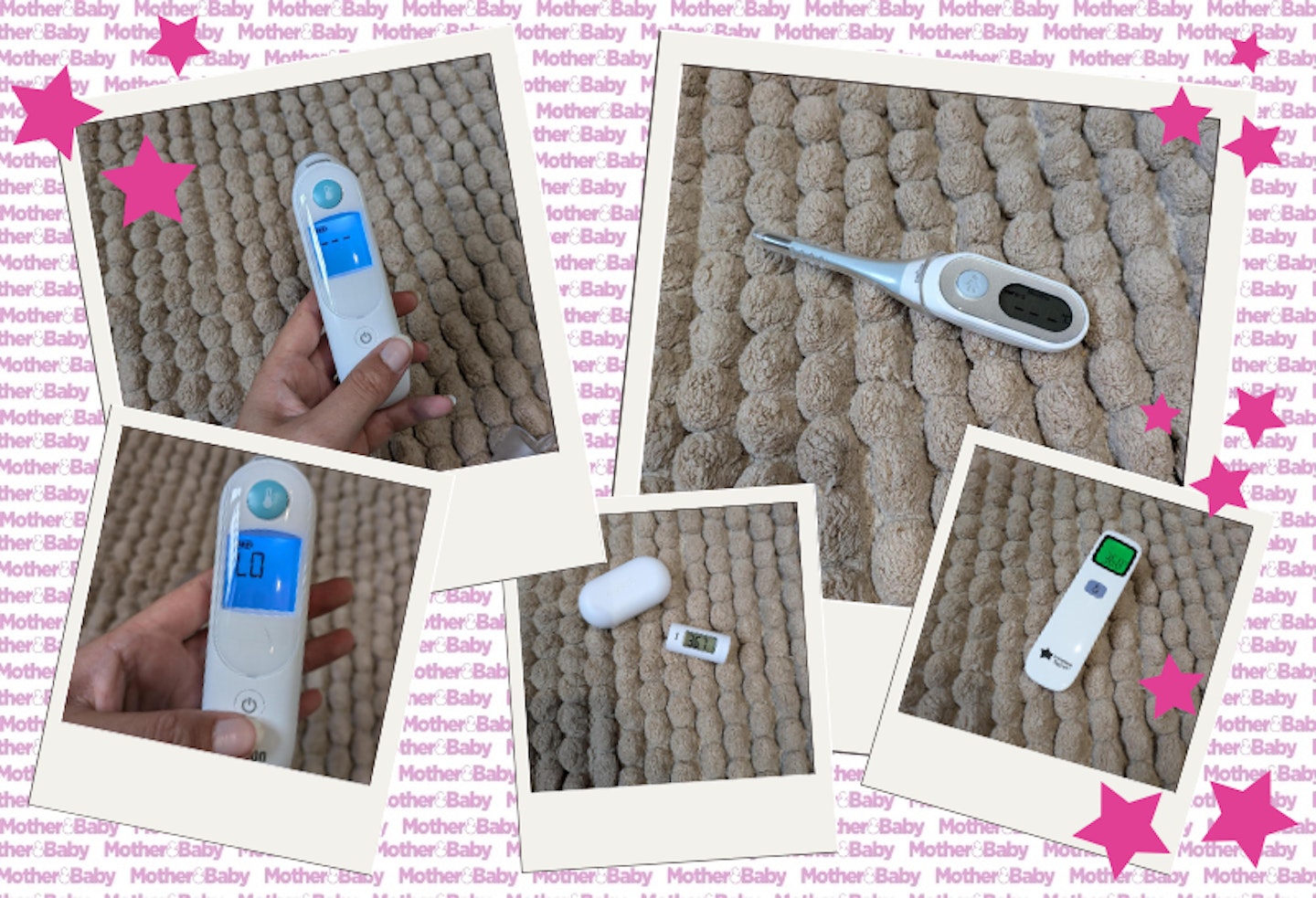
To help you take your baby's temperature, we managed to get our hands on some of these baby thermometers so that our parent testers can try them out at home. They have spent time testing these products so that they could share their honest thoughts and feedback on a variety of testing criteria – including how easy they were to use, how the products performed, what they liked about the design and features, and whether they felt the product was good value for money.
Find out more about how we test products for Mother&Baby by visiting our How We Test page.
The best baby thermometers 2025
Best overall baby thermometer
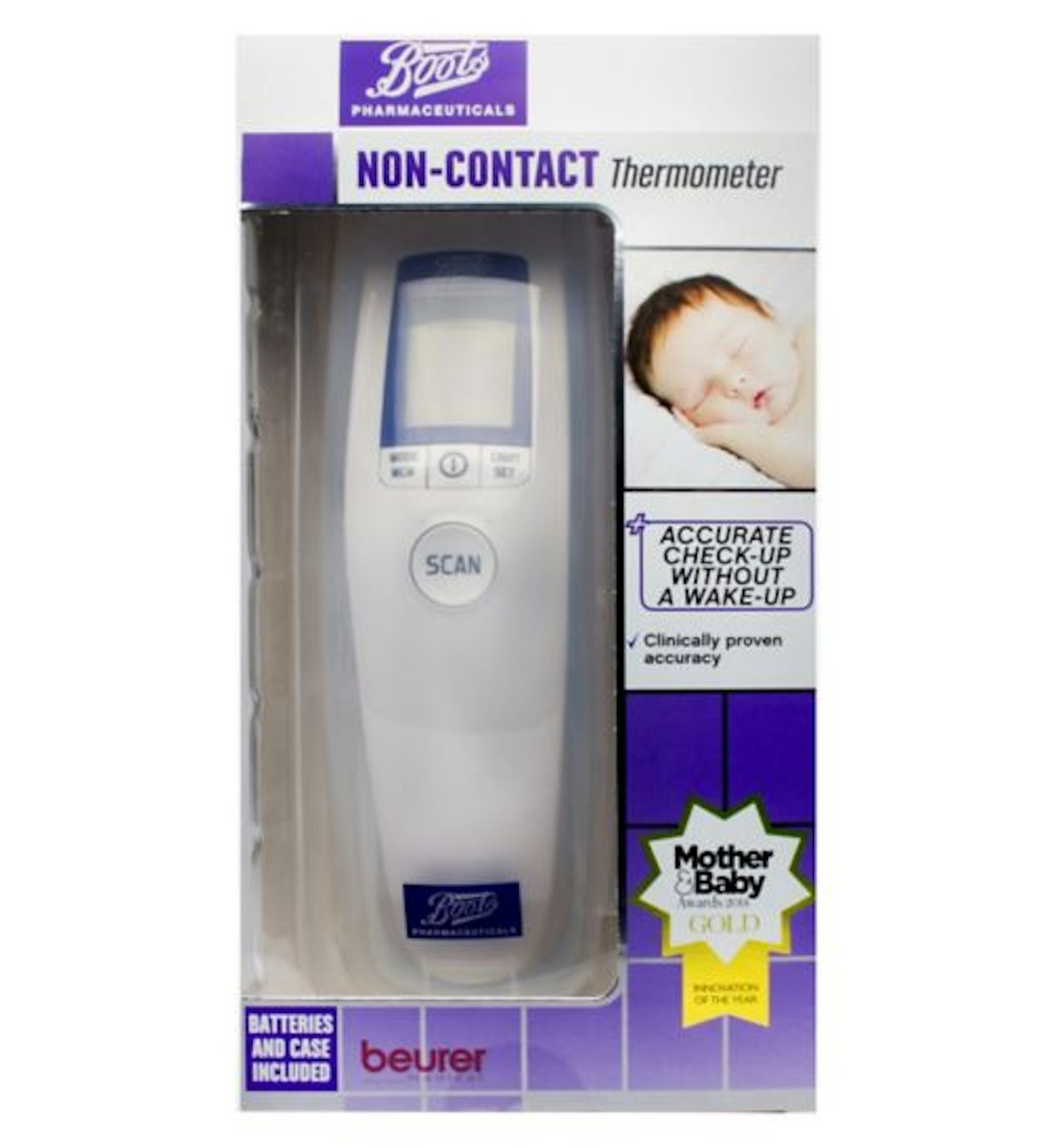 Image: Boots
Image: Bootswww.boots.com
We've chosen the Boots Pharmaceuticals Non-contact Thermometer as our best overall pick of baby thermometers as it's easy to use and offers a precise way for you to check your baby's temperature without disturbing their sleep – a must if your baby is resting off an illness. The non-contact design also ensures hygiene and comfort for your little one, minimising the spread of germs. Mum tester Michelle loved how easy it was, commenting, “I think the fact that you don't have to disturb baby is the best thing about it. It reads the temperature in as little as 2 seconds. It also stores the last 60 readings so you can see if their temperature has gone up or down.”
We like that it's a multipurpose tool, so you can also check the temperature of your baby's bottle, food, bathwater, and even your baby's room environment. The fact that the built-in memory stores your last 60 readings means you can easily track changes over time - a handy feature we loved! We also liked the sleek design and the fact it comes with its own storage case, making it ideal for travel and keeping in your nappy bag.
It features a unique symbol system, quickly showing whether your baby's temperature is within normal range or not, and saving any guesswork or uncertainty. Our mum tester Victoria did find it tricky to see the result at times though, saying, "I would change the fact that the light doesn’t come on automatically so sometimes you have to peer close to it to read the temperature."
Read our full Boots Non-contact Thermometer review
Pros
- Non-contact readings for hygiene and comfort
- Easy to use with results in 2 seconds
- Unique symbol system saves guesswork
- Comes with a storage case for travel
- Built-in memory to track readings over time
Cons
- Some found the screen a little too dark to read
| Mode: | Battery powered |
| Display: | Digital |
| Type: | Non contact |
- Multipurpose and non-contact: measures babies' bottle, food, bathwater and room temperature
- Automatic shut-off feature which prolongs battery life
- Built in memory records last 60 readings
- Adjustable display
2.
Tommee Tippee No Touch Forehead Thermometer
Best accurate baby thermometer
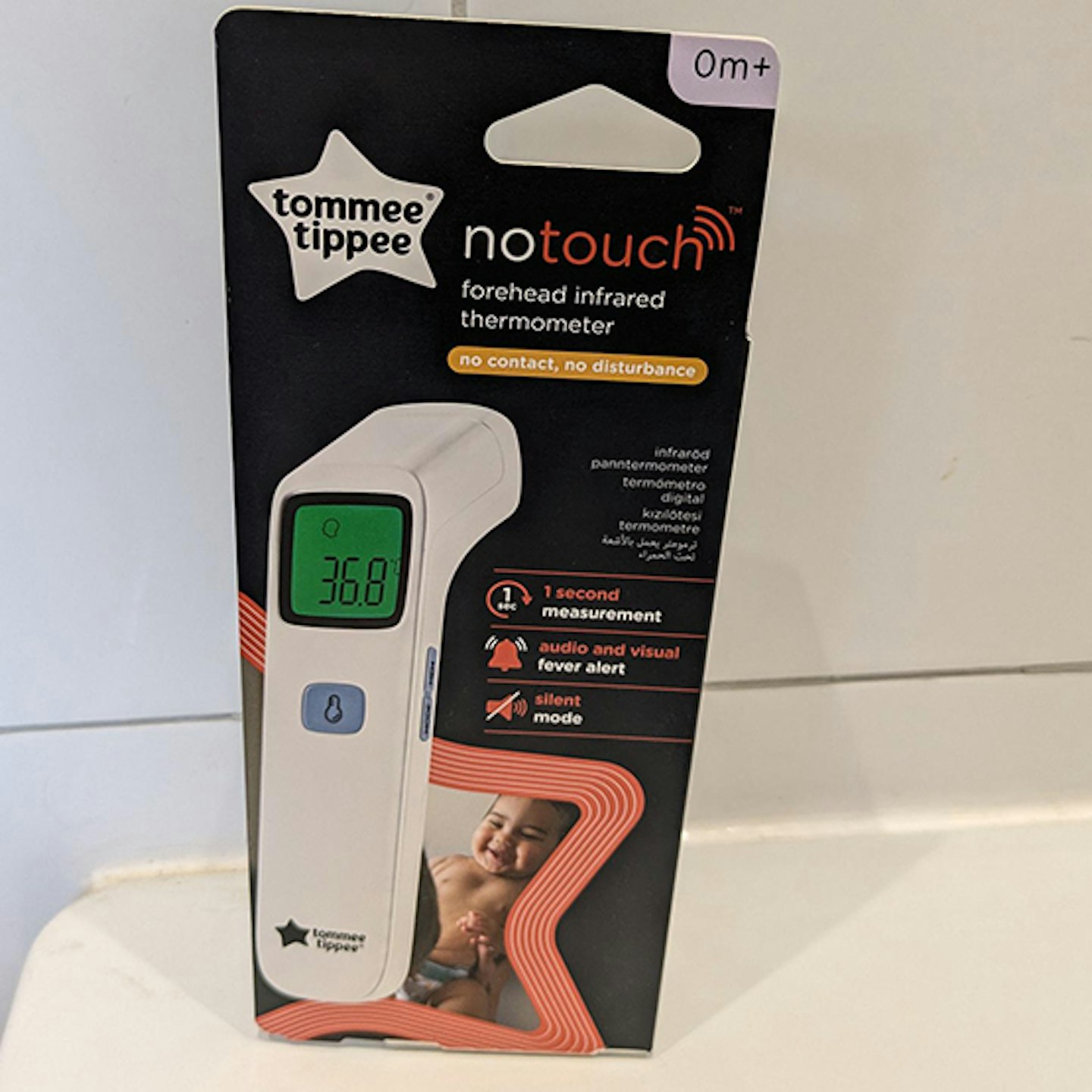 Image: Mother&baby
Image: Mother&babyWe chosen the Tommee Tippee, No Touch Forehead thermometer as our best pick for a clear display, which we know is important when trying to take little one's temperature. The thermometer offers quick and accurate temperature readings, without disturbing your child’s sleep, by holding the device 4cm away from the forehead and pressing a button. You'll get a reading within two seconds, displayed clearly on the LCD panel.
Our parent tester, Thokozani, found this thermometer very easy to use, commenting, "The accuracy and efficiency of the thermometer ensure that my daughter’s temperature is provided quickly. With traditional contact thermometers, if the child moves in any way, it could distort the reading of the thermometer. If the Digital forehead no-touch thermometer records a very high temperature, the Fever indication system alerts you the user by letting off three short beeps, followed by one long beep to warn of potential fever."
The thermometer stores previous readings for comparison over time, which our parent testers found very reassuring, and the readings to be consistent. Most liked the design, but some found it a little bulky compared to other, more sleek designs. Our mum tester Samantha said, “If I could change one thing about the thermometer, I’d change the size. It is bulkier than thermometers I’ve used previously meaning storage and transportation is a little more difficult. I found the grip uncomfortable when using it in one hand whilst contending with a wriggly toddler. A narrower device would work better for me." We think this is where the non-touch feature coomes into its own though, providing an easier way to take readings.
Read our full Tommee Tippee No Touch Forehead Thermometer review
Pros
- Non-touch and silent mode for easy usen during sleep
- Clear LCD panel for easy readings
- Get accurate results in seconds
- Has a clear fever indicator for peace of mind
- Stores last 20 readings in memory
Cons
- Doesn't come with a case for storage
- Some found it bulkier than other models
| Mode: | Battery powered |
| Connectivity: | Infrared |
| Display | LCD |
- Ready to use with batteries
- NoTouch forehead thermometer
- Reading appears in one second
Best colour-coded baby thermometer
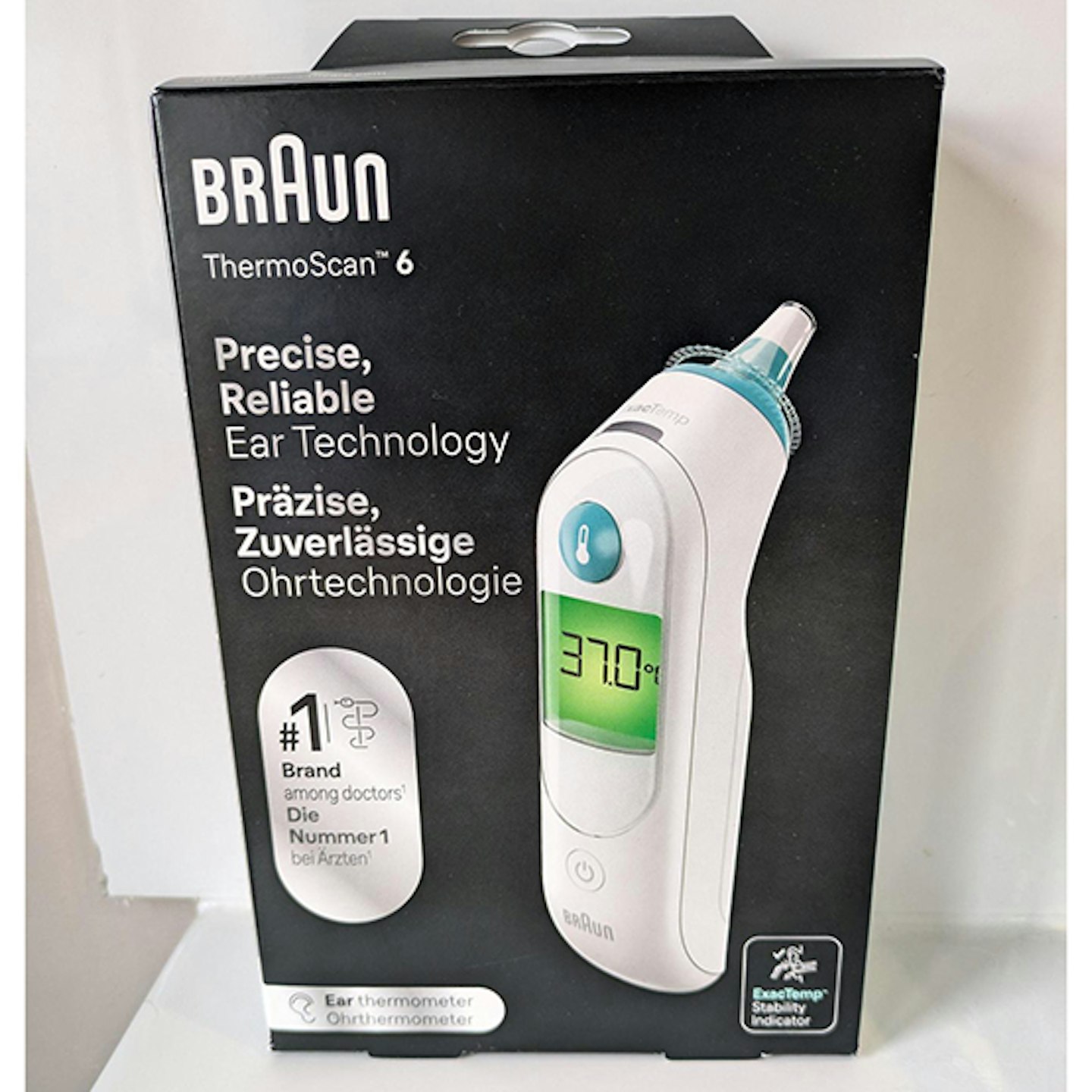 Image: Mother&Baby
Image: Mother&BabyThis ear thermometer offers professional-grade accuracy for measuring your baby's temperature, featuring a night light and colour-coded display so you can easily see if your baby has a fever. You can adjust the settings for accuracy according to your child's age too, making it suitable for the whole family. One of our parent testers found it easy to use and said, "My toddler won't allow me to use any other thermometer, but he is happy with this one. He got used to it and does not resist now. It only takes 3 seconds to get a measurement. If in doubt, you can always take another measurement!"
We like that the patented tip pre-warms, ensuring comfort for your little one. The thermometer is used in hospitals and GP surgeries, which also provdes peace of mind to users that it's a quality, approved product. Unfortunately, it isn't a non-contact device, but you can still use the thermometer when the baby is lying down or asleep, making it very convenient for parents.
Using the ear as a measurement site offers even more accuracy, reflecting the true core body temperature more precisely, and you'll get a result within seconds. In fact, the thermometer is clinically proven to be as accurate as rectal measurement in newborns! Don't worry, this is a good option for the best ear thermometer for baby as it's gentle on little ears and hygienic to use thanks to the hygiene caps provided, which ensure cleanliness. Refills can be purchased too. One mum tester said, “ itcomes with plenty of plastic covers, and the refills are cheap to buy.” In the box you’ll also find a storage container and simple instructions.
Pros
- Age-adjustable fever guidance – can be used by whole family
- Pre-warmed tip – comfortable to use for little ones
- Hygenic tip – with cap refills available to purchase separately
- Get results in seconds
- Approved product – used in hospitals and GP surgeries
- Clinically proven to be as accurate as rectal measurement in newborns
- Comes with storage box and simple instructions
Cons
- May disturb your sleeping baby because readings are taken in-ear
| Display: | Digital |
| Connectivity: | Infrared |
| Mode: | Battery powered |
- Comes with batteries included so ready to use
- Comes with a light and a beep to confirm a stable position and help ensure an accurate reading
- Colour coding based on the age of your child
- Backlit display
4.
Braun Digital Stick Thermometer
Best compact baby thermometer
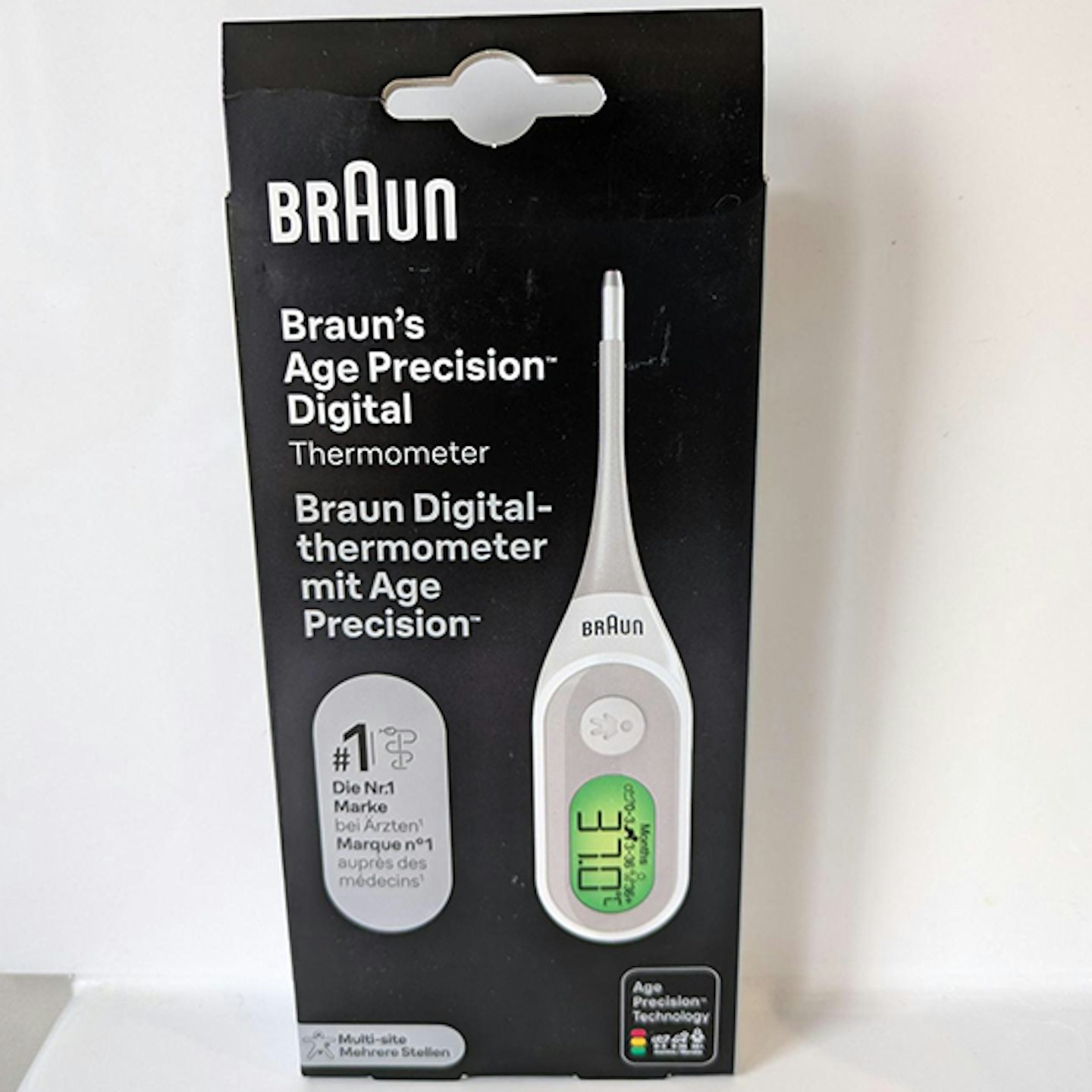 Image: Mother&Baby
Image: Mother&BabyWe chosen the Braun Digital Stick Thermometer for its compact size, making it highly portable and easy to fit into a changing bag or handbag. Its affordable price makes it accessible to all parents, and it can be used for the whole family with Braun's age precision technology. Temperature readings can be adjusted based on the age of the child, ensuring accuracy for babies, older children, and adults alike.
Using the thermometer is easy – just place it under your child's armpit, and you'll have a temperature reading within eight seconds. Its clinically proven accuracy provides reassurance for parents, with temperature measurements you can trust. One mum reviewer said, “It's fast, accurate, doesn't give unreliable readings, and it just works without a hassle.” Although, we noticed it gives readings within eight seconds which is significantly longer than other brands.
The thermometer features a gentle and flexible tip, ensuring comfortable usage. Plus, it offers multi-site usage choices making it suitable for oral, rectal, or underarm use, providing flexibility and convenience for parents. The main downside compared to other thermometers is that putting a thermometer under your child’s armpit when they’re not feeling well can be a little uncomfortable for them compared to other non-touch models. It’s a firm favourite amongst parents, however, with one returning parent commenting, "This is my second one of these thermometers. The first one was old and worn out. This latest one is very easy to use and quick to show temperature." They did find that the sound indicating completion doesn't always work though.
Pros
- Compact size fits easily into bags to take on the go
- Lower price point makes it accessible for most families
- Temperature readings are adjustable for whole family use
- Cinically proven accuracy for peace of mind
- Gentle, flexible tips for more comfort during use
- Simple to use with multi-site usage choices
Cons
- Takes longer to give a reading than other thermometers
| Connectivity technology: | Bluetooth |
| Display: | LCD |
| Mode: | Battery powered |
- 3-in-1 thermometer suitable for oral, rectal, or underarm use
- Simple, button operation comes ready to use with a battery included and a storage cap
5.
Munchkin Mini Thermometer
Best non contact baby thermometer
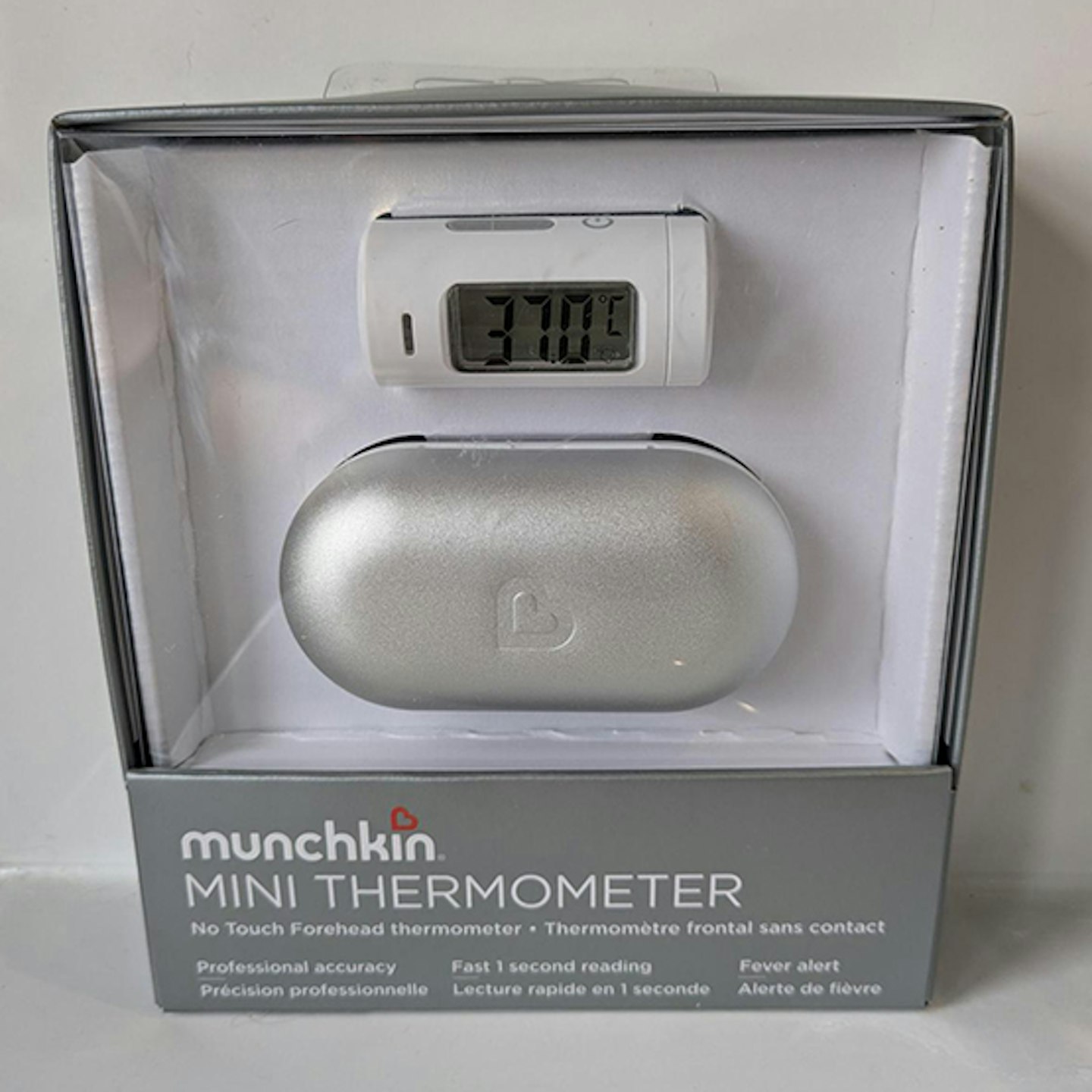 Image: Mother&Baby
Image: Mother&BabyIf you like the previous thermometer for being compact, you might like this one more with its convenient non-contact design. We really like this travel-friendly mini thermometer from Munchkin. The portable infrared forehead thermometer is great for use at home and on the go. Being impressively tiny and coming with its own travel case to keep it safe, it's ideal to pop in the changing bag or a suitcase. Despite its size it performs just as well as some of the big brand non-contact thermometers, and we like that it's easy and intuitive to use, and can store up to 20 readings.
One parent tester said, "Since non-contact thermometers are usually so bulky, I was a bit sceptical of how accurate this would be, but it gives spot-on readings in only 1 second. The fact that you can store readings as well is great. I'm so impressed with how compact it is, it makes it so much easier to take out and about and offers peace of mind if my little one is under the weather that I have it with me if I need to double check their temperature."
Unfortunately, we'd prefer to be able to turn off the beep it makes when giving a reading, as this could disturb babies and children if they're asleep. Other than that, our testers found this product hard to fault.
Pros
- Travel-sized with case included
- Non-contact design
- Performs just as well as full-size non-contact models
- Accurate readings in under 1 second
- Can store up to 20 readings
Cons
- No way to turn off the beep when it takes a reading
| Type: | Non contact |
| Display: | LCD |
| Mode: | Battery powered |
- Strong infrared non touch reading
- Provides an accurate temperature reading within 1 second
- Includes a protective case
Best easy to use baby thermometer
 Image: Amazon
Image: AmazonIf you're looking for an easy-to-use thermometer the Braun No Touch + forehead thermometer offers dual technology for quick and precise temperature readings. It has a touch mode for placing the thermometer on the forehead, as well as a no-touch mode for holding it in front of the child's forehead. This means you can check their temperature without disturbing their sleep or if little ones are being a bit wriggly. Our mum tester Laura loved this feature, commenting, "I could easily keep an eye on my sleeping child's temperature without disturbing him. It is quick and easy to use giving you a reading within 2 seconds."
The LED colour-changing backlight ensures easy reading in any light and changes colour depending on the temperature severity. Our mum tester loved the colour-adjusting backlight, saying it "makes it simple to recognise if your child is seriously ill as it glows Red, Amber & Green depending on the temperature range."
The thermometer also features patented technology for accurate temperature readings. We like that it's compact, fitting nicely into a changing bag, and that it doesn’t require disposable covers. The memory function allows continuous monitoring too. Some mums, however, would have liked the addition of a storage box or bag, with Mum tester Laura saying, “I would like a box or bag to keep this thermometer in to ensure it keeps clean and safe.”
Pros
- Choose from normal functioning to non-touch mode
- Fast readings in just 2 seconds
- Backlit colour-changing display makes it easy to read
- Compact size for on the go
- Non contact
Cons
- It doesn't come with a storage box or bag
| Type: | Non contact |
| Mode: | Battery powered |
| Display: | Digital |
- Back-lit, colour-coded display
- silent mode for middle-of-the-night readings
Best simple baby thermometer
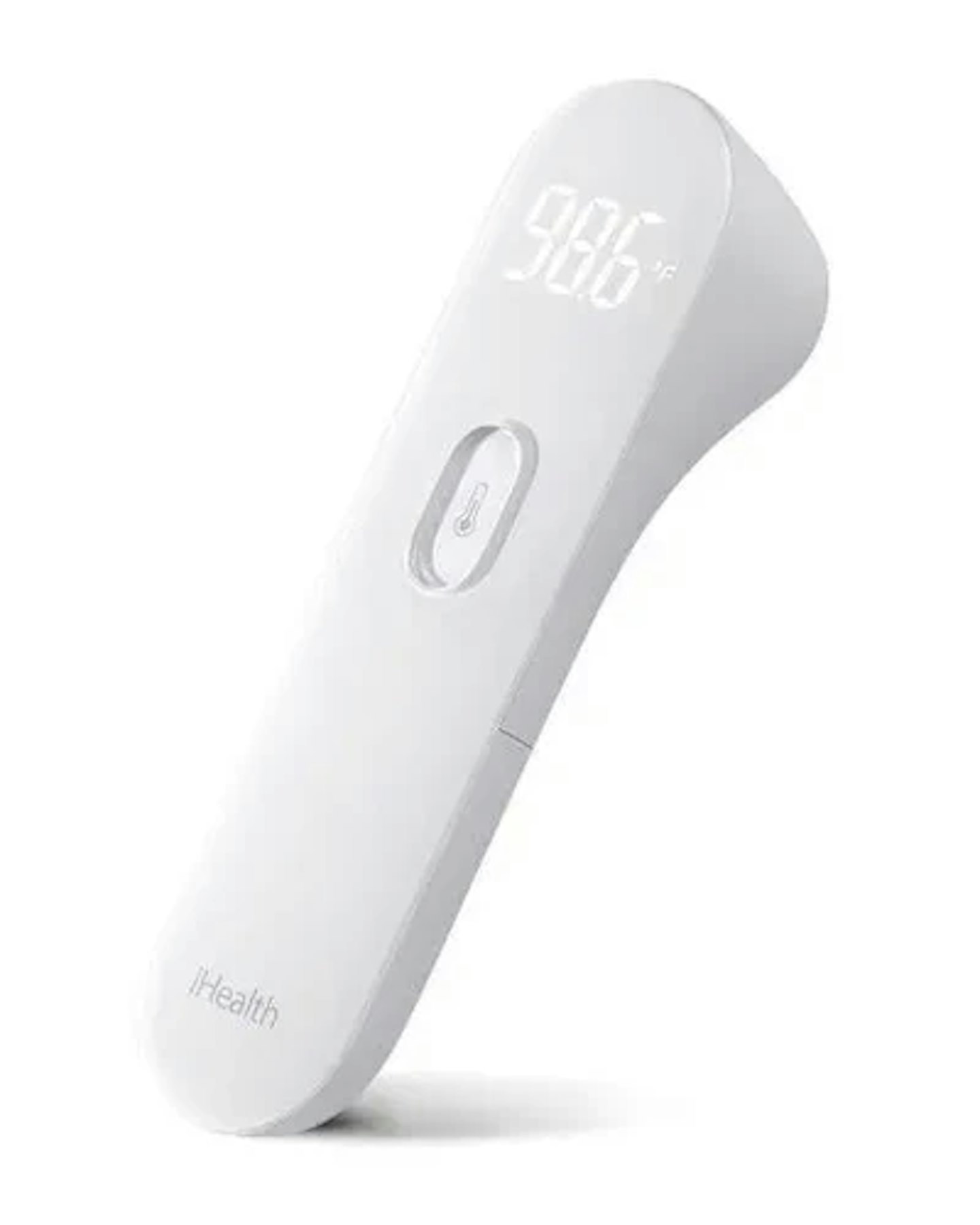 Image: Mother&Baby
Image: Mother&BabyWhen it comes to simplicity, the iHealth PT3 no-touch thermometer with infrared technology provides precise readings within 1 second from a distance of 2cm from the forehead's centre. It's super easy to use with single-button control and a quiet vibration alert for minimal disturbance, making it ideal for newborns and babies.
Equipped with three built-in sensors, including the ultra-sensitive infrared sensor and a distance sensor, it ensures maximum accuracy when you need it most. One mum tester loved the ease of use, commenting, "This thermometer is incredibly easy to use, with a simple one-button operation that quickly and accurately measures your body temperature. The large, easy-to-read display shows the temperature clearly, and the results are available within seconds." Parents also appreciate that the thermometer is suitable for all ages, making it excellent value for money for the whole family.
With no-touch measuring, it's a hygienic choice and it easy to clean. It operates with AAA batteries and provides readings in both Celsius and Fahrenheit, although some parents did note that changing the settings wasn’t straighforward. A parent said, “One thing that isn’t clear is how to change from Fahrenheit to Celsius. However, I did work it out. Press and hold the button for around 5 seconds, press the button to show ‘C’ in the window, then press and hold for 5 seconds to confirm.”
Pros
- Readings within 1 second from a distance of 2cm
- LED-backlit display with a clear, large reading
- Quiet vibration alert for unobtrusive nighttime use
- Maximum accuracy with three built-in sensors
- Suitable for all ages for the whole family
- Provides readings in both Fahrenheit and Celsius
Cons
- No on/off switch means it can activate and drain the battery
- Changing settings isn't straightforward
| Mode: | Battery powered |
| Connectivity: | Infrared |
| Display | LED |
- Reads body temperature within 1.18 inches from forehead without physical contact
- Can read from a bright extra-large LED screen, even in total darkness
- Ready to use with batteries included
Best quiet baby thermometer
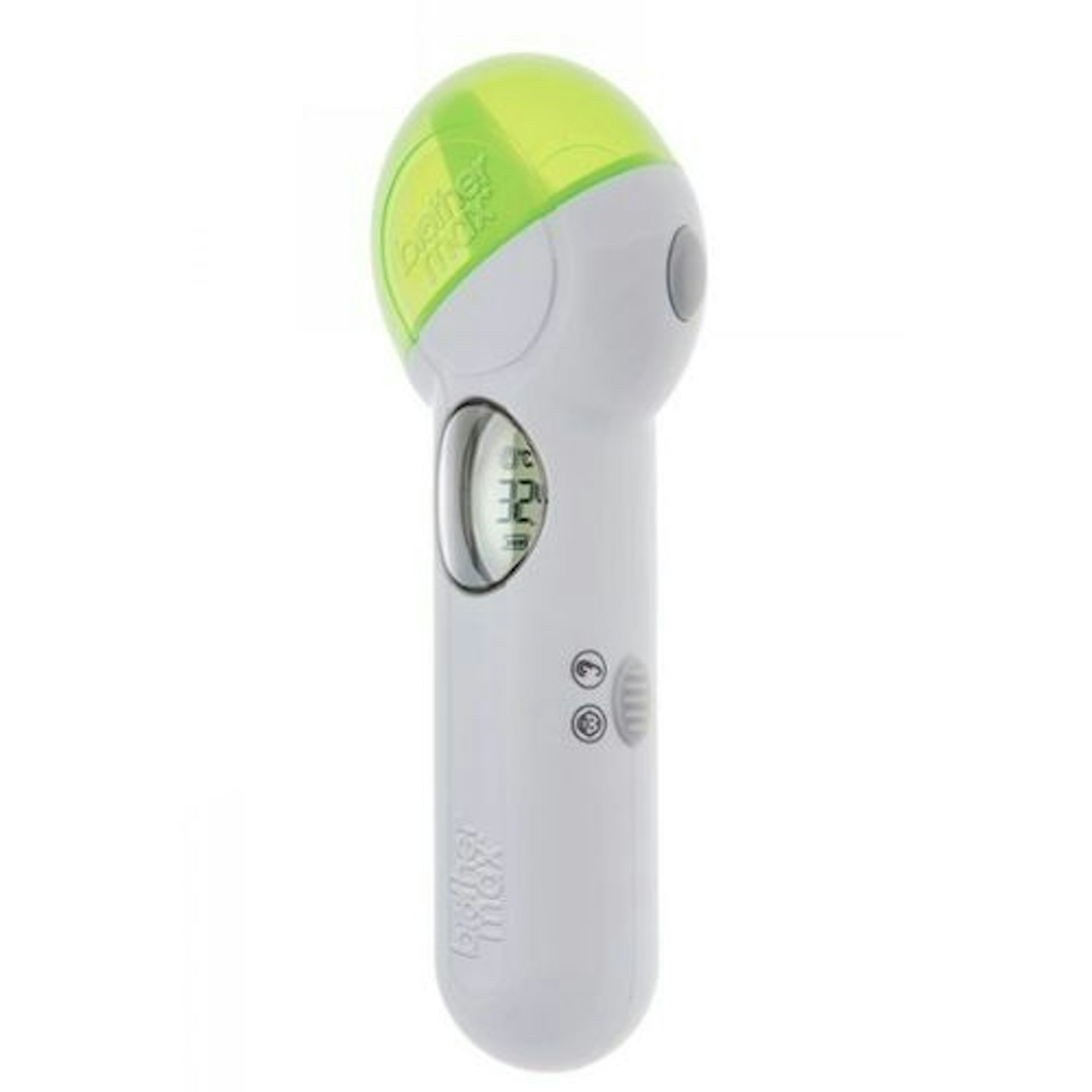 Image: Amazon
Image: AmazonWith silent operation and the option for zero-contact measurements, the Brother Max Infrared Digital 2-in-1 Head/Ear Thermometer is ideal for parents who struggle to get close to their little ones when they’re feeling under the weather. Suitable from birth, this thermometer provides quick and precise temperature readings from both the head and ear in just one second, accurate to 0.2°C. One mum reviewer said, "Easy and quick to use with accurate results, which is what I need as a mama!" Others felt it wasn't as accurate at some others on the market.
It features infrared technology for reliable results, and its 2-in-1 design eliminates the need for probe covers, simplifying the cleaning process. Additionally, it can be used as a non-contact thermometer by holding it 1 cm away from the forehead, providing further flexibility.
The thermometer is user-friendly and comes with clear instructions and a handy cover for storage. It's BPA and mercury-free, ensuring safety for the whole family. With a battery included, it's ready to use straight out of the box, making it a practical and reliable choice.
Pros
- 2-in-1 design means no need for probe covers
- One-touch readings
- Silent so it won't disturb a sleeping baby
- Clear instructions
- Handy cover for storage
- Battery included
Cons
- Some parents said the readings were not that accurate compared with others
| Mode: | Battery powered |
| Type: | Contact and non contact |
| Display: | Digital |
- Ready to use
- Both forehead & ear temperature readings with accurate infrared technology
9.
Femometer Forehead Thermometer
Best baby thermometer for quick results
 Image: Amazon
Image: AmazonIf you're after a thermometer that provides super quick results you'll like this one. With its straightforward operation, you can hold the Femometer thermometer 2-3cm away from the forehead and press the start button for a temperature reading in just 1 second. An instant red screen alerts you to a fever, ensuring quick identification of potential health concerns. We like the large LCD screen with 3 backlight indicators that make it easy to interpret results, with a warning sound for abnormal temperatures. One mum reviewer said, "This thermometer is the best I ever had! When you have little ones you need quick and easy! And this is that."
With infrared technology, it not only measures forehead temperature but can also gauge the temperature of objects and rooms. The thermometer features two modes: "Body" mode for measuring body temperature and "Surface" mode for measuring the temperature of water, bottles, and food, meaning it can double up as a bath thermometer and be used before giving your tot their bottle or food. Medically certified, it provides precise readings with its precise sensor probes.
Included in the package are the touchless infrared thermometer, user manual, and batteries, ensuring you're ready to use it right away. One mum reviewer commented, "I’ve tried ear thermometers with my daughter (9 months) but struggle to get a reading because her ears are so small. This head thermometer is brilliant and gives you an instant reading." Some have mentioned that the readings aren't as accurate as they'd like though.
Pros
- Non-contact thermometer
- Result in one second
- Large LCD screen with 3 backlit indicators
- Flashes red and beeps to alert of a fever
- Infrared tech means you can guage temperature of objects, rooms, water etc.
Cons
- Some parents found some of the readings were inaccurate
| Type | Non contact |
| Mode: | Battery |
| Display: | LCD |
| Connectivity: | Infrared |
- 3-in-1 Infrared thermometer
- Precise sensor probes and provides results within 1 second
- A large LCD screen with 3 backlight indicators
- The thermometer emits a warning sound for abnormal temperatures (red screen)
- 10 reading memory
How to choose a baby thermometer
Age of your child: If you want one for a newborn, get one that's suitable for them. Non contact options like infrared ones, won’t disturb a sleeping child. Some ear thermometers do come with tiny ear probes which are suitable for little ones. Meanwhile, toddlers may prefer under arm thermometers.
Ease of use: The most important thing is that it's easy to use. No one wants to spend time fiddling with it in the middle of the night and your baby is distressed. This comes down to personal preference - some parents may prefer the good old fashioned stick ones that they grew up with and some may prefer fancier models that store previous readings and flash different colours according to the temperature. Similarly, you want one that can measure your baby's thermometer in seconds rather than minutes.
Display: You want one that's easy to read day or night, some of the ones listed above come with back light display which is handy at night. Likewise, a thermometer that flashes in colour could also be handy.
Features: There’s no point having a baby thermometer with great features if you can’t work out how to use them. Some baby thermometers are colour coded green / orange / red. Some come with a sound to indicate high temperature or fever but if this comes on in the middle of the night, it may alarm your baby/toddler.
Price: We've reflected a good range of baby thermometers above from purse-friendly ones to the £40 mark so hopefully you can find something that works within your budget.
Understanding different types of baby thermometers
With so many baby thermometers available, here’s a quick guide to the different ones, so you can choose the best type of thermometer for your baby.
In-ear thermometers: Often used by doctors, these provide a quick, painless, and accurate temperature reading. While these are popular, they can sometimes be too large for the ears of very small babies, so do check this before you buy.
Non-contact thermometers (forehead): These use infrared to measure your baby’s temperature without physical contact.
Strip thermometers, these are cheaper and less accurate and the NHS recommends steering clear of them.
Armpit thermometers: The NHS still recommends these for newborns, as they provide a reliable reading, especially in younger babies.
Rectal thermometers: While considered more invasive, rectal thermometers offer the most accurate readings.
Room thermometers: The best room thermometers help ensure your baby’s room stays at a safe temperature (Experts suggest 16–20°C with a light blanket).
Bath thermometers: To ensure your baby’s bath is the perfect temperature (37-38°C), a bath thermometer is essential.
How to use a baby thermometer correctly
Guidelines on how to use a baby thermometer, according to the NHS:
1. Place the thermometer inside the top of the armpit
2. Gently close the arm over the thermometer and keep it pressed to the side of the body
3. Leave the thermometer in place for as long as it says in the instruction leaflet. Some digital thermometers beep when they're ready
4. Remove the thermometer. The display will show your child's temperature.
Don't forget that their temperature may be higher straight after a bath or if they've been wrapped up in a blanket, so wait a few minutes if you need to try again. You should always seek medical advice by calling the NHS Helpline on 111 if a baby under three months old has a temperature of 38°C or a baby between three and six months has a temperature of 39°C.
Hygiene and maintenance: Keeping your baby thermometer clean
When cleaning a baby thermometer, soap and water are generally good enough to use according to NHS guidelines. Check if your thermometer's plastic parts are suitable to sterilise and if not, use disposable ear covers. Non-contact thermometers need only a wipe down between use. You can also gently wipe the tip with an alcohol-based wipe or disinfectant but ensure it is completely dry before using. For ear thermometers, you can clean the tip the same way or replace the disposable earpiece if applicable.
When to worry: recognising and responding to fever in babies
Dr Elia Maalouf explains what a fever is and how to recognise it in your baby. "Infections are the most common reason your child will get a temperature. "When an infection invades your child's body, it mounts what's called an 'inflammatory response' against it." says Dr. Elia. "Blood circulation increases around the infected area, carrying the antibodies needed to fight it – this causes their temperature to rise, which also, happily, kills off some bacteria and viruses that can't take the heat."
This means that a higher-than-normal reading on the thermometer can actually be a positive sign. "It's an indication that your child's body is mounting an effective response to kill off the infection." says, Dr. Elia. "However, if your child has a temperature of 39.5 or above, you should always take action to try to lower it."
The NHS says: "If your child or baby has a high temperature, you can usually look after them at home. The temperature should go down over 1 to 4 days."
There are a few things you can do to try and bring your child's temperature down including:
• Provide plenty of fluids – or continue to breastfeed as normal
• Look out for signs of dehydration
• Give food if they want it
• Check on your child regularly – especially throughout the night
• Keep them at home
• Give either paracetamol or ibuprofen if they're distressed or uncomfortable. Always check the medicine is suitable for your child, or speak to a pharmacist or GP if you're unsure.
• Get medical advice if you're worried about your child, or if the paracetamol or ibuprofen isn't helping.
The NHS urges parents to seek urgent medical advice if their baby under three months old has a temperature of 38°C or is between three and six months old and has a temperature of 39°C.
FAQs on the best baby thermometers
When should I check a baby's temperature?
If your baby seems unwell, unusually fussy, or uncomfortable, checking their temperature is a good first step to understanding what’s wrong. While there could be many reasons for their behavior, taking their temperature helps rule out a fever. For babies under 2 months old with a fever, it’s best to check their temperature every two to four hours. For older babies, you won’t need to check as frequently, but tracking their temperature a few times a day is still helpful. Be sure to record the readings to share with their doctor if needed.
Which type of thermometer is most accurate for babies?
Rectal thermometers are considered the most accurate for babies as they measure the body’s core temperature directly. However, in-ear thermometers and non-contact forehead thermometers are also reliable and more convenient, especially for quick checks. The best choice depends on your baby’s age and comfort, with rectal thermometers often recommended for newborns and younger infants. Always follow the manufacturer’s instructions for accurate results.
What thermometer does NHS recommend?
The NHS recommends using a digital thermometer to check your baby's temperature. For babies under 4 weeks old, it's advised to measure their temperature under the armpit using an electronic thermometer. For children aged 4 weeks to 5 years, the NHS suggests measuring body temperature with an electronic thermometer in the axilla (armpit) or using an infrared tympanic (in-ear) thermometer. They advise against using forehead strip thermometers, as these are considered unreliable.
Is ear or forehead thermometer more accurate for babies?
Both forehead and ear thermometers can be effective for babies, but each has its strengths. Forehead thermometers are non-contact and easy to use, making them ideal for checking a temperature without disturbing a sleeping baby. Ear thermometers provide quick and accurate readings but may not be suitable for newborns due to their smaller ear canals. For the most reliable results, choose a thermometer designed specifically for your baby’s age and always follow the manufacturer's instructions.
Which thermometer is no longer recommended for use?
Glass mercury thermometers and forehead strip thermometers are no longer recommended for use. Glass mercury thermometers can break easily, posing a risk of mercury exposure, which is toxic. Similarly, forehead strip thermometers are unreliable and do not provide accurate readings. Instead, digital thermometers are safer, more reliable, and far more effective for checking your baby’s temperature. Always choose a thermometer that meets modern safety and accuracy standards.
How to check baby temperature without a thermometer?
If you don’t have a thermometer, you can check for signs of a fever by gently feeling your baby’s forehead, back, or chest with the back of your hand to see if they feel warmer than usual. However, this method is not accurate and should not replace a thermometer. Other signs of a fever may include flushed cheeks, unusual fussiness, poor feeding, or a higher-than-normal pulse. If you suspect your baby has a fever and you don’t have a thermometer, monitor their symptoms closely and seek medical advice if you’re concerned.
How to check baby temp with infrared thermometer
To check your baby’s temperature with an infrared thermometer, ensure it’s set to measure body temperature and follow the manufacturer's instructions. For non-contact thermometers, hold it 1-3 cm from your baby’s forehead and press the button for a quick reading. For in-ear infrared thermometers, gently place the probe into the ear canal without forcing it, then take the reading. Always make sure your baby is calm and still for the most accurate results, and clean the thermometer after use as per the guidelines.
How to use a forehead thermometer on a baby
To use a forehead thermometer on a baby, ensure the thermometer is set to body temperature mode and follow the manufacturer’s instructions. Gently place the thermometer on your baby’s forehead or hold it just above the skin if it’s non-contact. Move the thermometer smoothly across the forehead or hold it steady as directed, then press the button to take the reading. Ensure your baby is calm and still for the most accurate results, and avoid using the thermometer immediately after a bath or if the baby is sweaty, as this can affect accuracy. Always clean the thermometer after use.
Why you can trust us
At Mother&Baby, our mission is to provide accurate and reliable reviews, ensuring our readers receive honest and transparent information about the best products available.
Our testers are either pregnant, or real parents with a baby or toddler. This could be members of our editorial team, freelance parenting journalists or external reviewers from the Mother&Baby awards. Our Mother&Baby Awards are renowned in the industry and are among the most highly respected product awards for baby and parenting products. Every year, we arrange for thousands of independent parent reviewers to test the latest products on the market.
We don't accept payment from manufacturers for product reviews, and maintain our editorial independence. While we do work with commercial partners on advertorials, these will always be clearly labelled.
Our writers have full control over their content, ensuring that products are selected based solely on the needs of our readers. While we may earn commissions or other compensation from links on our website, this does not affect our product choices. These links allow us to continue offering valuable consumer advice, without compromising the integrity of our reviews. We are always honest in our reviews, and we won't recommend products that we wouldn't spend our own money on.
About the expert
Dr Elia Maalouf is a consultant paediatrician and neonatologist at the Portland Hospital for Women and Children, the UK's largest private children's hospital. Dr Elia Maalouf specialises in the treatment of fevers.
About the author
Zara Mohammed is a Digital Writer for Mother&Baby and a proud aunt to her teen niece. She has 10 years freelance writing experience creating lifestyle content for various platforms, including pregnancy, women’s health, parenting, child development and child mental health, plus lots of fun seasonal family articles and celebrity news.

